MILBY BUTLER, 1889-1971:
The Butler Longhorns Live On
By Deborah Sizemore
Photos Courtesy DeWitt Meshell
Milby Butler died October 16, 1971, a few months before his 83rd birthday. Years after his death, there still survives an identifiable type of Texas Longhorn cattle that bears the Butler name, which may be traced in an unbroken line to the native big-horned cattle of East Texas and the Gulf Coast. It is only chance that any survive at all. Most of Milby Butler's beloved Longhorns were butchered after he died, and the rest scattered. Through the efforts of a few breeders, the Butler cattle have grown in numbers and prominence in recent years and are favored by many now for their exceptional horn growth. To see how these cattle came to be, it is necessary to consider a time when pioneers came to southeast Texas to carve a life out of a grasslands wilderness.
The Butler family came to the grassy lowlands between Houston and Galveston in 1855, and is believed to have been the first family to settle on the "bald prairie" that would be the site of League City. George Washington Butler, Milby's father, was 9 years old when his family arrived by ox-train from Calcasieu Parish, Louisiana, bringing with them lumber from Louisiana to build their home.
As a teenager, George W. left League City to join the Confederate Army and did not return home until after the Civil War. The war interrupted the area's budding cattle industry, but afterward, in the 1870s, League City became the headquarters of a number of large ranches and was a railroad shipping point for cattle.
In 1872, George bought 30 acres of land adjoining the Galveston, Houston and Henderson tracks in League City. He built his home and ranch headquarters there. About 300 or 400 feet southeast of the house, he built a three-story barn. The first story housed his buggy, with pens and stalls for milk cows and horses. The second floor was feed storage and living quarters for his cowboys. The third floor was George's observatory, where he could look over the range with a telescope at his cattle.
The 30 acres was the only land Butler claimed, although his cattle ranged over an area estimated at 2,000 acres. At that time, all the land east from the G.H. & H. Railroad to the waters of Galveston Bay was called the Butler Ranch. By using the land without actually laying claim to it, Butler had the benefit of the open range without being liable for taxes.
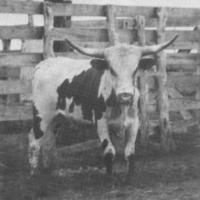 An old Butler bull
An old Butler bull
The country between Houston and Galveston was all free range then. Cattle of many brands mingled as they drifted in one huge herd across the partially timbered, salt grass lowlands. The herd stayed down in the tall grasses close to Galveston Bay until the mosquitoes and snakes became bad enough each spring to chase the cattle to higher ground. Fall round-ups were held before the herd drifted back to the lowlands. The cattle would be divided according to their brands, foremost among them George W. Butler's "OT" brand. Old-timers nicknamed Butler "Otee" after his famous brand, which had been given to him by his mother before 1872. The brand apparently stood for her initials.
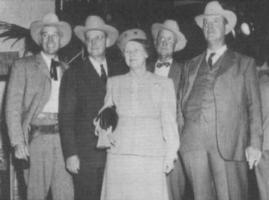 Milby Butler and friends.
Milby Butler and friends.
Milby Butler and friends, December 1946. Left to right: Wild Bill Elliot, Hollywood, CA; Wayne Fisher, Los Angeles, CA; Lucille Fisher, Los Angeles, CA; Butler; Claud Appling, Louise, TX.The most cattle that George W. Butler ever had under the OT brand at one time was about 25,000. In 1872, he bought 20,000 cattle at $1 a head, paid in gold with money borrowed from T. W. House in Houston. The interest rate was 17 percent.
The Butler Ranch became a rail road stop and mail drop, with the address "Butler's Ranch, G.H.& H. Railroad, Texas." People mailing letters would often come by the house, which was 200 or 300 feet from the tracks, and borrow a stamp from Butler. In bad weather, they'd gather on his front porch.
"This eventually became somewhat of a nuisance," according to G. I. Butler, son of Milby and grandson of George W., "so he had the railroad move an old section car into his yard as a depot where people could leave their mail and pick it up. In the 1880s, when this business of him providing stamps for people got to be a nuisance, he applied to the Post Office Department to have a lady here designated Postmaster and set up a little Post Office across the tracks in Clear Creek (forerunner of League City).
"It seems she couldn't be bonded for some reason, but they said that if he would assume the responsibility she could run the Post Office, so they designated him Postmaster of Clear Creek. He served for a number of years until somebody else could qualify."
Milby Butler was born January 31, 1889, one of George W. and Mary (Baker) Butler's six children. Milby's brothers were Henry and Andrew; his sisters, Mabel, Rebecca and Mary. A that time, the Butler Ranch was more of a summer home and the family maintained a house in Houston while George W. ranched in the Clear Creek area. Only Mary was born in Clear Creek. Milby and the other children were born in Houston.
The Butlers moved to the ranch while the children were young, and Milby grew up there by the railroad tracks, hearing the clackety-clack of passing trains and the lowing of Texas Longhorn cattle. "Longhorns have always been a part of my life," he once said. "I have had them all my life and have always been around them."
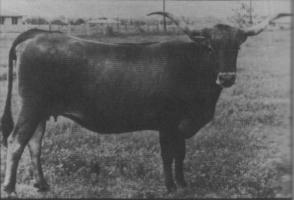
"Aunt Jemima," a young Butler bred Texas Longhorn that wears the OT brand.
George W. owned stock pens where the Butler Ranch joined the G.H. & H. Railroad. Tens of thousands of cattle came through those shipping pens on their way from Houston to the port city of Galveston. Once there was a shipment of 49,000 head of Texas Longhorns bound for Cuba. Over a period of time, all the cattle in the Cuba shipment were unloaded in the Butler stock pens before resuming their rail journey to the coast via the G.H.& H. The Butlers also had a slaughtering house through which many Longhorns passed. Each cow killed brought about $5 for the hide and tallow, and buttons were made from the horns. Slaughtering continued until wild Longhorns disappeared entirely and were replaced by foreign types of cattle, Milby remembered.
George W. Butler was a widely known and respected civic leader of early Clear Creek/League City. (The town changed its name several times between 1874 and 1902, its citizens unable for years to settle the question of whether the community was to be called Clear Creek or League City. Eventually League City won out.) Besides serving as postmaster, George W. was a Galveston County commissioner for six years and was the prime mover in securing a bridge across Galveston Bay to the City of Galveston. "This is conceded to be the longest wagon bridge in the world," reported the Texas Coast Promoter in 1896.
The first school in League City was built by George W. Butler on his land for the use of his children and his neighbors. The building was a log cabin. Butler served for many years as president of the school board.
"Mr. Butler is truly a broad-gauged, liberal-minded, industrious man, and one that has done much for his country," said the Promoter. "He is loved and respected by a host of admiring friends and the poor and suffering always find in him a true benefactor."
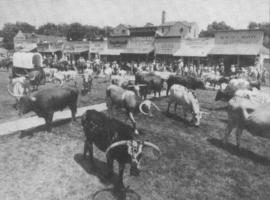
Many of the Butler steers were used on the Centennial Trail Drive to Dodge City in 1966. Photo was taken July 2, 1966.In 1907, he canvassed the property owners of League City to see who would pay $4 a piece for live oak trees to be planted by their sidewalks. Assisted by 18-year-old Milby, the elder Butler supervised the planting of the trees, many of which still shade the sidewalks of League City.
Milby said that his father was credited with bringing the first Brahman cattle into the area. The first female Brahman was brought there in 1883, and the first bull, he said, was brought in even earlier. Milby had a Brahman cow in his name by the time he was one week old.
Like many fathers, George W. thought that the business he was in was not suitable for his sons, so he tried to get them interested in some thing else. He put Henry in as a partner in a hardware-lumber store Andrew was fascinated by trains and finally a deal was made to get him on as a crewman on the G.H.& H Railroad.
"He finally got himself worked up to engineer but that didn't last too long since he liked to speed in the trains and he jumped them off the tracks a couple of times," recounts G. I. Butler.
Milby was put to work operating a soda fountain in a drug store. That lasted only a year or two before he sold out and established his ranching and cattle business near League City.
Apparently resigned to the fact that Milby was born to be a cattleman, George W. gave his son the OT brand around 1907 or 1908. Milby also used the MB brand at times. After George W. gave Milby his OT brand, he primarily used the AG brand until his death in 1921.
As a young man, Milby was noted in League City for his skill with a .30-30 Winchester. "He could shoot," recalls DeWitt Meshell, who knew Butler for many years. "He was the best there was with a rifle. He could shoot the eye out of a dog running. Nobody compared to him."
He could shoot a wolf on the run from horseback and break its neck, confirms G. I. Butler.
Milby married a girl from Topeka, Kansas, named Ceole Winnefred Gird. They had three children: G. I., Henry, and Mary Nell.
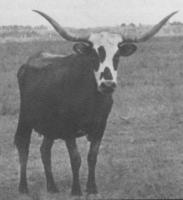
"Fox Tail," a favorite cow of Milby Butler's.
In 1923, Milby separated the Texas Longhorns from the rest of his cattle. Though his main interest at the time was his herd of registered Brahman cattle, Milby took an active interest also in preserving the native Longhorns.
Native East Texas big-horned cattle were relatively abundant in the area before 1930. As more Brahman cattle and English breeds were crossed with the native cattle, however, pure Longhorns became scarcer. In 1931, Butler traded two Brahman cows for a white "flea- bitten" Longhorn cow from East Texas. She was a medium-sized cow with a double-twist corkscrew shape to her horns. Her coloring was white speckled, with red ears, red-ringed eyes and nose, and red-speckled ankles. This color pattern became so marked in the Butler cattle that it often was referred to in later years as "Butler color."
Milby also added the blood of a few twisted-horned Mexican cattle to his herd of East Texas and Gulf Coast Longhorns. By 1956, he had about 550 head of cattle.
In 1957, when Milby was in his late 60s, a load of hay fell on him and broke his neck, according to his son. Milby was crippled for six months, but even an accident as serious as that couldn't keep him down. He be came an enthusiastic supporter of the Texas Longhorn Breeders Association of America upon its formation in 1964. He registered about 20 bulls and 300 cows during the first years of the association. Many Butler steers were used in the Centennial Trail Drive to Dodge City in 1966.
Milby loved horns. He would have the neighborhood kids gather the big-horned cattle every so often and rub lanolin into their horns to keep them shiny and healthy looking. If a cow had nicked or splintered a horn, the kids were instructed to sand down the rough places so every head sported a flawless set of horns.
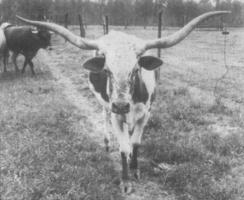
Beauty in 1982.Milby bred for horns. His cows were carefully selected and put with the bull that he thought would give him length, base and corkscrew shape in the horns of their offspring. Most of his herd sires were out of the cows with the best corkscrew horns. Color, he said, was unpredictable. Breed for the horns and you'll get color, he believed.
He used many white and roan bulls as herd sires. The Butler cattle originally were mostly red and brown in color. In the last years of Milby's life, as many as half of his cattle were white with red ears. The color change probably was the result of breeding the white bulls to solid cows.
When the TLBAA started to sponsor sales, Milby consigned several cows to help out. It was very rare for him to ever let a cow go. "I never sell my Longhorns," he once said. "Like the silver dollars, there are not going to be any more, we can only preserve the Longhorns we have!"
If he liked you, however, he might give you enough heifers and a bull to get you started. And in his later years he did sell a modest number to close friends and neighbors.
Perhaps the most famous of all the Butler cattle were Bevo and Beauty. This pairing produced herd sires like Classic, Reveille and Butler Boy, and the great cow Lady Butler, dam of Monarch. Bevo, born in 1963, was Milby Butler's favorite herd sire and the result of years of selective breeding.
DeWitt Meshell has described the Butler Texas Longhorn as a type of Longhorn all its own. Garnet Brooks confirmed this. "They were unusual cattle and different from other Longhorn herds," Brooks reported after an inspection tour of the Butler herd. "They were a bigger framed cattle than most southeast Texas cattle. Many could be considered outstanding on horns."
Yet Milby worried that the lack of new blood suitable for introduction into his herd was affecting horn quality. Commenting on how the Longhorn had gradually changed over the years, he said, "The most noticeable change is in the thickness of the horns. The horns get perpetually thinner."
Milby for many years searched for outside blood that could strengthen the genetic base of his cattle, without detracting from the long, Texas-twist horns that were characteristic of his herd. With only one documented exception, Milby never used a bull that he didn't raise.
When Milby Butler died, his cattle were almost lost. "Eighty percent of those cattle went to the slaughter house," remembers DeWitt Meshell. "He had over 600 head of mama cows in 1965. I'm talking about all culled out, all handpicked cows. Most of them went to the slaughterhouse." Meshell credits Blackie Graves, J. W. Issacs, and the Partlows with being among the breeders who helped keep the bloodline from vanishing.
Even so, Meshell says, there are not very many Butler cattle around today. Classic has put a lot of them on the market, but otherwise, he sighs, "there's just not very many left with true Butler breeding."
Meshell remembers Milby B as a knowledgeable cattleman and breeder. "He was just a true rancher, I guess you could say, with ideas. He had big ideas all the way through. He was a true breeder, he knew what to do with crosses."
For all his years of experience with the cattle, Milby Butler did not claim to be an expert Texas Longhorn breeder. "You can study Longhorns all of your life," he once said, "but you can never truly know the animals. I just like the cattle and respect them, I don't claim to know a lot about Longhorns."
Nevertheless, Milby Butler be counted among the most important and influential breeders in the history of Texas Longhorn cattle The bloodline that bears his name has left an indelible stamp upon uncounted numbers of cattle, spanning decades of the breed's development.
Thanks to G. I. Butler of League City, Texas; Toni Lambert of the League City Public Library; and DeWitt Meshell of Groveton, Texas, for their help in preparing this history.
Note: Milby Butler 1889-1971: The Butler Longhorns Live On, by Deborah Sizemore, was reprinted with permission from The Longhorn Scene, October, 1983.